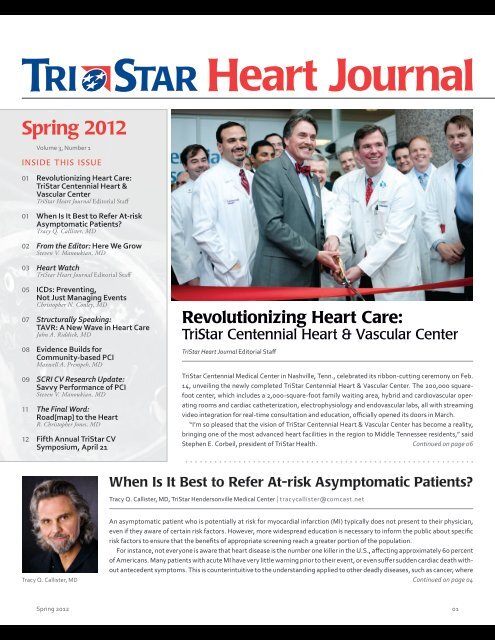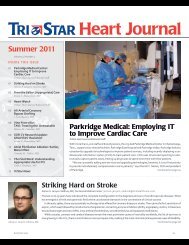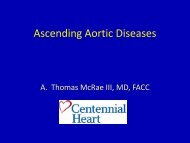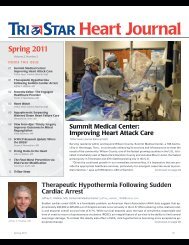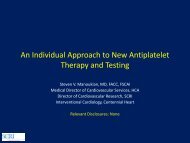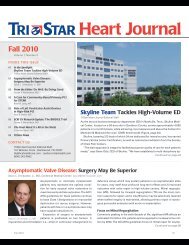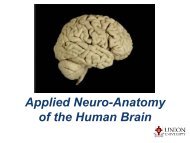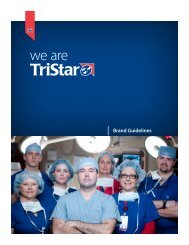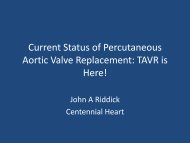Spring 2012 - TriStar Health
Spring 2012 - TriStar Health
Spring 2012 - TriStar Health
You also want an ePaper? Increase the reach of your titles
YUMPU automatically turns print PDFs into web optimized ePapers that Google loves.
<strong>Spring</strong> <strong>2012</strong><br />
Volume 3, Number 1<br />
INSIDE THIS ISSUE<br />
01 Revolutionizing Heart Care:<br />
<strong>TriStar</strong> Centennial Heart &<br />
Vascular Center<br />
<strong>TriStar</strong> Heart Journal Editorial Staff<br />
01 When Is It Best to Refer At-risk<br />
Asymptomatic Patients?<br />
Tracy Q. Callister, MD<br />
02 From the Editor: Here We Grow<br />
Steven V. Manoukian, MD<br />
03 Heart Watch<br />
<strong>TriStar</strong> Heart Journal Editorial Staff<br />
05 ICDs: Preventing,<br />
Not Just Managing Events<br />
Christopher N. Conley, MD<br />
07 Structurally Speaking:<br />
TAVR: A New Wave in Heart Care<br />
John A. Riddick, MD<br />
08 Evidence Builds for<br />
Community-based PCI<br />
Maxwell A. Prempeh, MD<br />
09 SCRI CV Research Update:<br />
Savvy Performance of PCI<br />
Steven V. Manoukian, MD<br />
11 The Final Word:<br />
Road[map] to the Heart<br />
R. Christopher Jones, MD<br />
12 Fifth Annual <strong>TriStar</strong> CV<br />
Symposium, April 21<br />
Revolutionizing Heart Care:<br />
<strong>TriStar</strong> Centennial Heart & Vascular Center<br />
<strong>TriStar</strong> Heart Journal Editorial Staff<br />
<strong>TriStar</strong> Centennial Medical Center in Nashville, Tenn., celebrated its ribbon-cutting ceremony on Feb.<br />
14, unveiling the newly completed <strong>TriStar</strong> Centennial Heart & Vascular Center. The 200,000 squarefoot<br />
center, which includes a 2,000-square-foot family waiting area, hybrid and cardiovascular operating<br />
rooms and cardiac catheterization, electrophysiology and endovascular labs, all with streaming<br />
video integration for real-time consultation and education, officially opened its doors in March.<br />
“I’m so pleased that the vision of <strong>TriStar</strong> Centennial Heart & Vascular Center has become a reality,<br />
bringing one of the most advanced heart facilities in the region to Middle Tennessee residents,” said<br />
Stephen E. Corbeil, president of <strong>TriStar</strong> <strong>Health</strong>.<br />
Continued on page 06<br />
When Is It Best to Refer At-risk Asymptomatic Patients?<br />
Tracy Q. Callister, MD, <strong>TriStar</strong> Hendersonville Medical Center ∣ tracycallister@comcast.net<br />
Tracy Q. Callister, MD<br />
An asymptomatic patient who is potentially at risk for myocardial infarction (MI) typically does not present to their physician,<br />
even if they aware of certain risk factors. However, more widespread education is necessary to inform the public about specific<br />
risk factors to ensure that the benefits of appropriate screening reach a greater portion of the population.<br />
For instance, not everyone is aware that heart disease is the number one killer in the U.S., affecting approximately 60 percent<br />
of Americans. Many patients with acute MI have very little warning prior to their event, or even suffer sudden cardiac death without<br />
antecedent symptoms. This is counterintuitive to the understanding applied to other deadly diseases, such as cancer, where<br />
Continued on page 04<br />
<strong>Spring</strong> <strong>2012</strong> 01
From the Editor<br />
Here We Grow<br />
Steven V. Manoukian, MD, Medical Director, Cardiovascular Services, Hospital Corporation of America ∣ steven.manoukian@hcahealthcare.com<br />
Editor-in-Chief<br />
Steven V. Manoukian, MD,<br />
Hospital Corporation of<br />
America<br />
EDITORIAL BOARD<br />
Cardiac Imaging<br />
David C. Huneycutt, Jr., MD<br />
<strong>TriStar</strong> Centennial Medical<br />
Center, Nashville, Tenn.<br />
david.huneycutt@<br />
hcahealthcare.com<br />
Cardiothoracic Surgery<br />
Davis C. Drinkwater, Jr., MD<br />
<strong>TriStar</strong> Centennial Medical<br />
Center, Nashville, Tenn.<br />
davis@ddrinkwater.com<br />
Electrophysiology<br />
Gregory G. Bashian, MD<br />
<strong>TriStar</strong> Centennial Medical<br />
Center, Nashville, Tenn.<br />
gregory.bashian@<br />
hcahealthcare.com<br />
General Cardiology<br />
David E. Chambers, MD<br />
<strong>TriStar</strong> Horizon Medical Center<br />
Dickson, Tenn.<br />
dchambers@dicksonmd.com<br />
Structural Heart<br />
John A. Riddick, MD<br />
<strong>TriStar</strong> Centennial Medical<br />
Center, Nashville, Tenn.<br />
john.riddick@<br />
hcahealthcare.com<br />
CONTACT US<br />
<strong>TriStar</strong> Heart Journal<br />
Editorial Staff<br />
110 Winners Circle<br />
Brentwood, TN 37027<br />
thj@hcahealthcare.com<br />
cardiac.tristarhealth.com<br />
(800) 242-5662<br />
Welcome to Volume 3 of the <strong>TriStar</strong> Heart Journal! It is hard to believe that three years have passed<br />
since its inception. During that time, we have expanded from eight to 12 pages, and our editorial board<br />
has grown from one to six experts, now encompassing much of the cardiovascular spectrum.<br />
This issue, we are pleased to welcome Dr. John A. Riddick to THJ’s editorial board as structural heart<br />
editor. Dr. Riddick completed his general and interventional cardiology fellowships at Emory University<br />
School of Medicine in Atlanta. An accomplished interventional cardiologist with particular expertise in<br />
structural heart disease, he will be leading the transcatheter aortic valve replacement (TAVR) program<br />
at the <strong>TriStar</strong> Centennial Heart & Vascular Center. Consequently, his regular commentary on TAVR<br />
and other rapidly-developing areas of structural heart disease will be particularly informative, as is<br />
evidenced by his prior THJ contributions.<br />
In the last three years, THJ also has added other regular columns such as View From Afar, which features<br />
cardiovascular experts from beyond <strong>TriStar</strong>’s boundaries and Heart Watch, which succinctly reports and<br />
comments on timely cardiovascular publications and presentations from major scientific meetings.<br />
Growth also has occurred beyond THJ, with the naming of <strong>TriStar</strong> <strong>Health</strong>’s new president, Stephen E.<br />
Corbeil, an experienced healthcare executive who is firmly committed to the provision of high-quality<br />
healthcare. Paul Rutledge, president of the Hospital Corporation of America’s Central Group described<br />
Mr. Corbeil as an “outstanding multi-hospital leader with a proven track record.” Also, as we report<br />
in our Facility Spotlight cover story, the <strong>TriStar</strong> Centennial Heart & Vascular Center recently opened,<br />
following a ribbon cutting ceremony,<br />
which [appropriately] occurred on<br />
Valentine’s Day. This new center<br />
will allow top-notch clinicians<br />
to utilize state-of-the-art<br />
technology to enhance the<br />
already high level of patient<br />
care they provide for years<br />
to come.<br />
Lastly, SCRI’s<br />
cardiovascular research<br />
program also continues<br />
unprecedented growth, not<br />
only in its size and scope at<br />
<strong>TriStar</strong> Centennial and <strong>TriStar</strong><br />
Redmond Regional Medical<br />
Centers, but beyond <strong>TriStar</strong> at its four additional research centers in<br />
Virginia and Florida, and two additional anticipated centers in Georgia<br />
and California.<br />
Although this unparalleled growth within <strong>TriStar</strong> <strong>Health</strong> and SCRI will<br />
no doubt continue, THJ’s vision always will remain the same, to provide the<br />
highest-quality, evidence-based cardiovascular literature to providers, in<br />
order to facilitate the enhancement of patient care.<br />
For author inquiries, contact steven.manoukian@hcahealthcare.com<br />
02 <strong>TriStar</strong> Heart Journal
Heart Watch<br />
AHA: Is triple therapy possible for post-PCI ACS patients?<br />
The lower of the two doses of the oral anticoagulant rivaroxaban<br />
(Xarelto, Bayer/Johnson & Johnson) evaluated in ATLAS ACS 2-TIMI<br />
51 showed promise, with a reduction in overall and cardiovascular<br />
(CV) mortality compared with placebo, despite an increased risk of<br />
bleeding and intracranial hemorrhage (ICH). The trial was presented<br />
at the 2011 American Heart Association (AHA) scientific sessions<br />
in Orlando, Fla.<br />
In this double-blind, placebo-controlled trial, Gibson et al. randomly<br />
assigned 15,526 patients with a recent acute coronary syndrome<br />
(ACS) to receive twice-daily doses of either 2.5 mg or 5 mg of<br />
rivaroxaban or placebo for a mean of 13 months and up to 31 months.<br />
Rivaroxaban significantly reduced the primary efficacy endpoint—a<br />
composite of death from CV causes, myocardial infarction<br />
or stroke—compared with placebo, with respective rates of 8.9%<br />
and 10.7%, and significant improvement for both the twice-daily<br />
2.5 mg dose (9.1% vs. 10.7%) and the twice-daily 5 mg dose (8.8%<br />
vs. 10.7%). The twice-daily 2.5 mg dose of rivaroxaban reduced the<br />
rates of death from CV causes (2.7% vs. 4.1%) and from any cause<br />
(2.9% vs. 4.5%), a survival benefit that was not seen with the twicedaily<br />
5 mg dose. Compared with placebo, rivaroxaban significantly<br />
increased the rates of major bleeding not related to coronary artery<br />
bypass grafting (2.1% vs. 0.6%) and ICH (0.6% vs. 0.2%), but<br />
not a significant increase in fatal bleeding (0.3% vs. 0.2%) or other<br />
adverse events. The twice-daily 2.5 mg dose resulted in fewer fatal<br />
bleeding events than the twice-daily 5 mg dose (0.1% vs. 0.4%).<br />
››<br />
Commentary: “This trial is a provocative look at the addition of an<br />
oral factor Xa inhibitor to dual anti-platelet therapy in post-PCI ACS<br />
patients. While the efficacy is positive in reduction of the primary<br />
endpoint of CV death, MI or stroke, this came at the expense of increased<br />
intracranial and major bleeding.” ~ Gregory G. Bashian, MD<br />
TCT: Two-year mortality benefits hold strong for TAVR<br />
At two years, in patients with symptomatic severe aortic stenosis<br />
who are not suitable candidates for surgery, transcatheter aortic<br />
valve replacement (TAVR) remained superior to standard therapy<br />
with incremental benefit from one to one years, reducing the rates<br />
of all-cause mortality, CV mortality and repeat hospitalization,<br />
based on the PARTNER B data presented at the 2011 Transcatheter<br />
Cardiovascular Therapeutics (TCT) meeting in San Francisco. However,<br />
there were more neurologic events in the TAVR arm.<br />
Cohort B of the PARTNER trial, which included patients with severe<br />
aortic stenosis who were not candidates for surgery, randomized<br />
358 patients to transfemoral TAVR with an early generation<br />
balloon-expandable valve (Sapien, Edwards Lifesciences) or standard<br />
therapy (including balloon valvuloplasty) at 21 centers.<br />
Compared with standard therapy at two years, TAVR showed<br />
significant reduction in the rates of all-cause mortality (18.2% vs.<br />
35.1%), CV mortality (13.2% vs. 32.1%) and repeat hospitalization<br />
(35% vs. 72.5 %).<br />
Overall, there were significantly more neurologic events in TAVR<br />
patients compared to standard therapy (16.2% vs. 5.5%) with five<br />
new events (three strokes and two transient ischemia attacks) between<br />
one to two years in TAVR patients.<br />
››<br />
Commentary: “In appropriate hands, TAVR offers a clear advantage<br />
for aortic stenosis patients who are inoperable or high-risk surgical<br />
candidates. As technology and experience mature, neurologic<br />
complications will decline, the procedure will become appropriate<br />
for a broader population and surgical aortic valve replacement will<br />
be obviated in the majority of patients. ~ Steven V. Manoukian, MD<br />
Hospitalization Through Two Years<br />
TAVI<br />
Standard Therapy<br />
Repeat Hospitalizations (No.) 78 151<br />
Repeat Hospitalizations (%) 35.0% 72.5%<br />
Days Alive Out of Hospital (Median) 699 355<br />
Source: 2011 Transcatheter Cardiovascular Therapeutics (TCT) conference.<br />
AHA: High-dose Lipitor, Crestor both shine in SATURN<br />
Both rosuvastatin (Crestor, AstraZeneca) and atorvastin (Lipitor,<br />
Pfizer) at maximum dose lowered LDL cholesterol levels, raised<br />
HDL levels and reduced atherosclerotic plaque in the SATURN trial,<br />
presented at the 2011 AHA scientific sessions. While the Phase II<br />
trial failed to find any significant difference between the two drugs<br />
to limit or reverse coronary artery disease (CAD) progression, it<br />
showed that a high-dose regime is safe and well tolerated.<br />
Nicholls et al. enrolled 1,385 patients with symptomatic CAD and an<br />
angiographically confirmed coronary stenosis of greater than 20%<br />
and LDL cholesterol levels of more than 80 mg/dl or, if untreated with<br />
a statin in the preceding four weeks, LDL cholesterol levels of more<br />
than 100 mg/dl. Patients were randomized to either a rosuvastatin<br />
group (694 patients, 40 mg dose daily) or an atorvastatin group<br />
(691 patients, 80 mg daily dose). An analysis of baseline cholesterol<br />
levels gave the edge to rosuvastatin over atorvastatin for LDL (62.6<br />
mg/dl vs. 70.2 mg/dl), and for HDL (50.4 mg/dl vs. 48.6 mg/dl).<br />
The percent of atheroma volume (PAV) decreased by 0.99% with<br />
atorvastatin and by 1.22% with rosuvastatin. The researchers<br />
found a statistically significant difference in total atheroma<br />
volume findings, with rosuvastatin at -6.39 mm 3 compared with<br />
atorvastatin at -4.42 mm 3 .<br />
››<br />
Commentary: “Data are now mounting that high-potency statin<br />
therapy can lead to a reduction in atheroma volume. With a multitude<br />
of clinical trials showing positive effects on hard endpoints, this elegant<br />
study further underscores the importance of statins in the management<br />
of coronary artery disease.” ~ David C. Huneycutt, Jr., MD •<br />
<strong>Spring</strong> <strong>2012</strong> 03
When Is It Best to Refer At-risk Asymptomatic Patients? (cont’d)<br />
Coronary Death or Nonfatal MI<br />
20%<br />
16%<br />
12%<br />
8%<br />
4%<br />
0%<br />
Continued from page 01<br />
Predicted 7-year event rates from COX<br />
regression model for coronary heart<br />
disease, death or nonfatal MI for categories<br />
of FRS or CACS<br />
Pairwise analyses compared the highest CACS level (>300)<br />
with each of the lower levels of CACS within each FRS<br />
group. Analysis of variance with pairwise comparisons<br />
revealed a statistically significant difference between a<br />
CACS of >300 and each of the other three<br />
CACS groups for an FRS of >10% and<br />
between a CACS of >300 and a CACS of<br />
zero for an FRS of
ICDs:<br />
Christopher N. Conley, MD, <strong>TriStar</strong> Skyline Medical Center | christopher.conley@hcahealthcare.com<br />
Preventing, Not Just<br />
Managing, Events<br />
Sudden cardiac arrest is a major cause of death in the U.S. Annually, more than<br />
300,000 U.S. patients (about one patient every two minutes) suffer cardiac<br />
arrest and most (approximately 95% of out-of-hospital events) will succumb to<br />
this disease state.<br />
Sudden cardiac arrest (SCA) is defined<br />
as the onset of cardiovascular<br />
collapse within an hour of symptoms.<br />
Although these events are often the<br />
Christopher N. Conley, MD manifestation of acute myocardial infarction<br />
(MI), they may be the result of<br />
chronic conditions, particularly congestive heart failure (CHF) with<br />
associated impaired systolic function and ejection fraction, frequently<br />
as a consequence of prior MI(s).<br />
Mortality Rate<br />
0.4<br />
0.3<br />
0.2<br />
0.1<br />
0.0<br />
Additional conditions predisposing patients<br />
to cardiac arrest are genetic afflictions,<br />
such as the Brugada and long QT<br />
syndromes and hypertrophic cardiomyopathy,<br />
among others.<br />
In years past, the use of implantable<br />
cardioverter-defibrillators (ICDs) for the<br />
detection and treatment of SCA was<br />
limited to patients who were fortunate<br />
enough to have survived an initial event,<br />
(secondary prevention of sudden cardiac<br />
death [SCD]). However, most patients<br />
with an initial out-of-hospital event either<br />
do not survive and/or suffer significant<br />
neurologic impairment.<br />
Recent clinical practice strategies,<br />
based upon newer data, have focused on<br />
primary prevention of SCA; that is, identifying<br />
and targeting high-risk patients<br />
for ICD implantation prior to the occurrence<br />
of an event.<br />
The MADIT study 1 , published in 1996,<br />
is oft-cited as a turning point in this approach.<br />
Patients with prior MI and significantly<br />
reduced systolic function were<br />
randomized to ICD or no ICD, with an electrophysiologic<br />
study performed in each. In<br />
patients randomized to ICD implantation,<br />
a survival benefit was demonstrated. This<br />
was followed by other research, including<br />
the pivotal MADIT II study 2 , which again showed a survival benefit<br />
for ICDs in patients with coronary artery disease, prior MI and systolic<br />
heart failure, with no qualifying electrophysiologic study performed.<br />
Additional research has validated the benefit of ICDs versus medical<br />
therapy (with or without amiodarone) in systolic heart failure<br />
patients with or without coronary artery disease or in ischemic and<br />
non-ischemic patients (SCD-HeFT 3 ).<br />
Continued on page 10<br />
Kaplan-Meier Estimates of Death from Any Cause<br />
Hazard Ratio (97.5% CI) P Value<br />
Amiodarone vs. Placedo 1.06 (0.86-1.30) 0.53<br />
ICD Therapy vs. Placebo 0.77 (0.62-0.96) 0.007<br />
Amiodarone<br />
(240 deaths; 5-yr rate, 0.340)<br />
0 12 24 36 48 60<br />
Months of Follow-up<br />
Placebo<br />
(244 deaths; 5-yr rate, 0.361)<br />
ICD Therapy<br />
(182 deaths; 5-yr rate, 0.289)<br />
No. at Risk<br />
Amiodarone 845 772 715 484 280 97<br />
Placebo 847 797 724 505 304 89<br />
ICD Therapy 829 778 733 501 304 103<br />
Bardy GH et al. N Engl J Med 2005;352:225-237.<br />
<strong>Spring</strong> <strong>2012</strong> 05
Revolutionizing Heart Care: <strong>TriStar</strong> Centennial Heart & Vascular Center (cont’d)<br />
Continued from page 01<br />
“We are excited to offer Middle Tennessee communities access<br />
to the region’s most advanced heart care program led by a team of<br />
renowned heart and vascular specialists,” Thomas Herron, CEO of<br />
<strong>TriStar</strong> Centennial Medical Center, concurred.<br />
There are approximately 30-40 cardiologists, including 15 interventional<br />
cardiologists and five cardiothoracic surgeons.<br />
“<strong>TriStar</strong> Centennial’s new Heart & Vascular Center is a state-ofthe-art<br />
facility spanning the entire cardiovascular spectrum,” added<br />
Steven V. Manoukian, MD, medical director of cardiovascular<br />
services at Hospital Corporation of America (HCA), <strong>TriStar</strong> Centennial’s<br />
parent organization. “This new facility will move <strong>TriStar</strong><br />
Centennial to the next level, by coupling the latest technology with<br />
well-trained, experienced providers in order to facilitate the highest<br />
quality of care, both from the patient outcomes and the patient<br />
satisfaction perspectives.”<br />
“Our vision was to create a heart and vascular center developed<br />
with our patients in mind,” Herron added. “This new facility, combined<br />
with the network of physicians at our <strong>TriStar</strong> family of hospitals,<br />
will greatly expand the quality and trusted care for our current<br />
and potential patients for decades to come.”<br />
While the cardiovascular services provided at <strong>TriStar</strong> Centennial<br />
Medical have grown over the past few years, these services were being<br />
delivered across the entire campus. “Our biggest desire in bringing<br />
all those imaging, surgical and cath lab procedures under one<br />
By the Numbers: Facility Fact Sheet<br />
✓ 32 Coronary Care Unit (CCU)<br />
Patient Rooms (16 of the rooms<br />
are new)<br />
✓ 28 Private Prep/Post Care<br />
(Recovery) Rooms (8 for<br />
overnight stay)<br />
✓ 6 PACU (Post Anesthesia Care<br />
Unit) beds<br />
✓ 16 New Cardiovascular<br />
Intensive Care Unit (CVICU)<br />
beds- directly adjacent to<br />
CVOR’s<br />
✓ 7 Procedure Rooms<br />
✓ 2 Electrophysiology Labs<br />
✓ 4 Catheterization Labs<br />
✓ 1 Endovascular Lab<br />
✓ 6 Open Prep/ PACU Bays<br />
✓ 4 Cardiovascular Operating<br />
Room (CVOR’s) with streaming<br />
video for consultation and<br />
education<br />
✓ 4 Echocardiogram Rooms<br />
(Two Stress Echo Rooms<br />
and Two Transthoracic Echo<br />
Rooms), Pulmonary Function<br />
Lab, Nuclear Cardiology Lab,<br />
Cardio-Pulmonary Exercise Lab<br />
and EKG Area<br />
✓ 3 Patient Holding Bays in Non-<br />
Invasive Cardiology<br />
✓ 3 Transesophageal<br />
Echocardiography (TEE) Rooms<br />
✓ 2 Private Family Waiting<br />
Rooms<br />
✓ 1 Hybrid Operating Room<br />
✓ 1 Central Pharmacy (new)<br />
✓ 1 Large Classroom & 2<br />
Education Classrooms<br />
✓ 2,000 square-foot Family<br />
Waiting Area with coffee<br />
bar and library, computers,<br />
televisions, two private consult<br />
rooms and patient tracker board<br />
roof is to deliver a more-integrated, uniform<br />
approach across the patient care<br />
continuum,” said James Drumwright,<br />
chief operating officer of the <strong>TriStar</strong> Centennial<br />
Heart & Vascular Center.<br />
In addition, the new hybrid operating<br />
room, along with multiple new technologies,<br />
will allow the facility to provide<br />
unique services to the Nashville region,<br />
such as transcatheter aortic valve replacement<br />
(TAVR), as well as endograft<br />
and peripheral procedures, which Centennial<br />
could not previously offer.<br />
TAVR is a recently approved procedure<br />
in the U.S. for patients with inoperable<br />
aortic stenosis, who previously<br />
had no other treatment option. However,<br />
the U.S. Food and Drug Administration<br />
and the Centers for Medicare &<br />
Medicaid Services have proposed stipulations<br />
about having appropriate equipment<br />
in the hybrid operating room and a<br />
designated heart team to ensure collaborative<br />
decision-making, such as the one<br />
designed at the new facility.<br />
“We are going to be a TAVR center, which will be one of the four<br />
functions of the hybrid operating room,” said Christopher Jones,<br />
MD, chair of cardiovascular medicine at the <strong>TriStar</strong> Centennial<br />
Heart & Vascular Center. The four disease states that the hybrid operating<br />
room will care for will be coronary artery disease, valvular<br />
disease, atrial fibrillation and vascular disease.<br />
Having all the cardiac surgeons, interventional cardiologists, cardiologists,<br />
cardiac nurses and medical professionals in one location<br />
allows for the entire cardiac team to execute on protocols in a unified,<br />
timely fashion. For example, if it is determined that a patient<br />
being treated in the catheterization lab requires surgery, there will<br />
be a new approach. “Previously, in this case, the interventionalists<br />
and the surgeons were located in different areas of the campus, so<br />
the procedure would need to stopped, the patient would be sent<br />
home with instructions to follow up with a surgeon on a different<br />
day,” said Drumwright. “Now, the surgeons are located next door to<br />
the cath lab, and can be called in to consult while the patient is still<br />
on the cath lab table.” This close proximity allows for more timely<br />
decision making, while enhancing the convenience of the patient.<br />
Also, greater collaboration between the various cardiac specialists<br />
only serves to propel the quality of patient care.<br />
At the <strong>TriStar</strong> Centennial Heart & Vascular Center, there are three<br />
dedicated areas of connectivity: cardiac specialists are all immediately<br />
accessible to one another; physicians and patients outside of<br />
06 <strong>TriStar</strong> Heart Journal
Structurally Speaking<br />
TAVR: A New Wave in<br />
Heart Care<br />
John A. Riddick, MD, <strong>TriStar</strong> Centennial Medical Center<br />
john.riddick@hcahealthcare.com<br />
<strong>TriStar</strong> Centennial can obtain real-time support from the heart experts<br />
at <strong>TriStar</strong> Centennial; and finally, there are large areas of the<br />
facility, as well as specific policies, established for enhanced communication<br />
between physicians, patients and their families.<br />
Also, the physicians at <strong>TriStar</strong> Centennial Heart & Vascular Center<br />
can use handheld devices to access medical records or monitor<br />
cardiac and other vital signs of patients. However, to achieve true<br />
technological interoperability between facilities, Jones pointed out<br />
that Centennial benefits from is its affiliation with HCA. “In the near<br />
future, true electronic connectivity will be possible, so that patients<br />
at smaller facilities can receive real-time support from larger, more<br />
advanced centers,” he said. “Electronic connectivity is a key component<br />
to providing high-quality care—not only at <strong>TriStar</strong> Centennial—but<br />
throughout the U.S.”<br />
“Combined with the network of physicians at our family of hospitals,<br />
this new facility will greatly expand the quality and compassionate<br />
care that patients have come to know and trust from <strong>TriStar</strong><br />
Centennial,” Corbeil said. “ Without a doubt, our commitment<br />
to quality patient outcomes and providing an unparalleled patient<br />
experience will make a difference in thousands of lives each year.” •<br />
On the Cover: Thomas Herron, CEO, <strong>TriStar</strong> Centennial Medical Center, (left-center)<br />
and Thomas A. McRae, III, MD, representing the multi-specialty team of <strong>TriStar</strong><br />
Centennial Heart & Vascular Center heart care specialists, prepare to mark the facility<br />
grand opening with a ceremonial ribbon cutting Feb. 14.<br />
Above: Hybrid operating room at <strong>TriStar</strong> Centennial Heart & Vascular Center<br />
Aortic stenosis (AS) affects more than<br />
4% of the North American population<br />
age 75 years and older 1 and is associated<br />
with high mortality in untreated patients<br />
(approximately 50% in the first<br />
two years after symptom onset) 2 . Typical<br />
findings include a systolic murmur in<br />
the aortic area radiating into the neck,<br />
often associated with a delayed and/or<br />
diminished carotid pulse. Echocardiography<br />
confirms the diagnosis.<br />
John A. Riddick, MD<br />
Medical therapy is largely ineffective,<br />
due to mechanical obstruction of the aortic valve. Surgical aortic<br />
valve replacement (AVR) in appropriate settings is a Class I indication,<br />
although 30 to more than 40 percent of patients may be<br />
deemed inoperable, due to factors such as advanced age, comorbidities<br />
and poor heart function.<br />
In order to provide an option for inoperable patients with severe<br />
symptomatic AS, minimally invasive transcatheter aortic valve replacement<br />
(TAVR) became available in Europe in 2007 and was recently<br />
approved by the FDA in November 2011. TAVR is performed<br />
via the transfemoral (percutaneous) or transapical (minimally invasive<br />
surgical incision) approach. Randomized controlled trials in the<br />
U.S., including PARTNER A 3 , also have assessed the technology for a<br />
broader population of high-risk patients who are candidates for surgical<br />
AVR. In this trial, all-cause mortality was numerically lower for<br />
TAVR vs. surgical AVR (3.4% vs. 6.5% at 30 days and 24.2% vs. 26.8%<br />
at one year). Over time, it is anticipated that TAVR operators will become<br />
more proficient, devices will become more refined, outcomes<br />
will improve further and TAVR will be seen as a less-invasive alternative<br />
to surgical AVR.<br />
The TAVR program at <strong>TriStar</strong> Centennial Heart & Vascular Center<br />
features a state-of-the-art hybrid operating suite coupled with experienced<br />
and collaborative interventional cardiology and surgical<br />
teams. Patients referred for evaluation are first assessed to determine<br />
if aortic valve intervention is indicated and second to determine<br />
the best means to achieve a high-quality outcome.<br />
REFERENCES:<br />
1. Nkomo VT, Gardin JM, Skelton TN, et al. “Burden of Valvular Heart Diseases: A<br />
Population-based Study.” Lancet 2006;368:1005-1011.<br />
2. Bonow RO, Carabello BA, Chatterjee K, et al. “2008 Focused update incorporated<br />
into the ACC/AHA 2006 Guidelines for the Management of Patients with valvular<br />
heart disease.” Circulation 2008;118:e523-e661<br />
3. Smith CR, Leon MB, Mack MJ, et al. “Transcatheter versus Surgical Aortic-Valve<br />
Replacement in High-Risk Patients.” N Engl J Med 2011;364:2187-2219.<br />
For more information or to refer a patient, please contact:<br />
Emily Y. Bradley RN, ANP-BC, TAVR Coordinator, <strong>TriStar</strong> Centennial Heart<br />
and Vascular Center, (615) 515-1915, Emily.Bradley2@hcahealthcare.com<br />
<strong>Spring</strong> <strong>2012</strong> 07
Evidence Builds for Community-based PCI<br />
Maxwell A. Prempeh, MD, <strong>TriStar</strong> Cartersville Medical Center ∣ maxwell.prempeh@harbinclinic.com<br />
More than one million percutaneous coronary interventions (PCIs) are performed<br />
annually in the U.S., the majority of which are not emergent. For many years,<br />
the cardiovascular societies recommended that the procedure not be performed<br />
in institutions that did not offer back-up coronary artery bypass graft surgery<br />
(CABG) capabilities, in case of complications. This limited patient access to PCI in<br />
many communities.<br />
However, as success rates for PCI have<br />
Maxwell A. Prempeh, MD continued to climb and the need of<br />
emergency CABG has declined, the<br />
most recent American College of Cardiology/American Heart Association/Society<br />
for Cardiac Angiography and Interventions (ACC/<br />
AHA/SCAI) guidelines, issued in November 2011, rectified that recommendation.<br />
The document reads that elective PCI might be considered<br />
in hospitals without on-site cardiac surgery,<br />
provided that appropriate planning for program development<br />
has been accomplished and rigorous clinical<br />
and angiographic criteria are used for proper patient<br />
selection 1 . This is now a Class IIb indication.<br />
Previously, multiple single-center studies have<br />
shown that there is no increase in complications if<br />
PCI is conducted without surgical backup. Adding to<br />
this evidence, the C-PORT E trial was presented as a<br />
late-breaking clinical trial at last year’s AHA scientific<br />
sessions 2 . C-PORT E, involving 60 centers and more<br />
than 18,000 PCI patients, compared the six-week and<br />
nine-month outcomes of non-primary PCI performed<br />
at hospitals with and without onsite cardiac surgery.<br />
The six-week mortality and the rate of emergency<br />
CABG were no different when PCI was performed at<br />
hospitals with or without onsite cardiac surgery.<br />
During the above AHA sessions, Thomas R. Aversano,<br />
MD, the lead investigator of the C-PORT E trial, said that he<br />
and his colleagues “do not support the spread of angioplasty to every<br />
hospital in the United States. However, it can be burdensome<br />
and costly for all medical centers to have cardiac surgery capabilities.<br />
And it doesn’t make sense to create more surgical programs<br />
just to support the angioplasty programs.” He added that in the<br />
1980s, the need for cardiac surgery was high, with 5 to 7 percent of<br />
PCI cases requiring CABG, but now the rate is closer to “one in 500<br />
or one in 1,000. It’s very uncommon.”<br />
As Dr. Aversano suggested, transferring patients who require interventional<br />
procedures to other facilities can add time, anxiety and<br />
costs for patients and their families, which can be alleviated by providing<br />
the services locally. Particularly with acute myocardial infarction,<br />
time is of the essence, as each minute of delay to the interventional<br />
procedure can cause muscle death—and even patient death.<br />
Many community hospitals throughout the U.S. are currently<br />
choosing to transfer PCI patients, and even if they devise a process<br />
to expedite the transfer, it can still result damage to the heart muscle.<br />
At <strong>TriStar</strong> Cartersville Medical Center, we recently began a program<br />
to treat our burgeoning local population that delivers PCI care<br />
Outcomes from C-PORT E Trial<br />
No Surgical<br />
Back-up<br />
With Surgical<br />
Back-up<br />
Patients 13,995 4,523<br />
P Value<br />
% male 63.9 63.2 0.36<br />
Age (mean) 63.9 64 0.40<br />
Left anterior descending (%) 46.2 45.4 0.35<br />
Right coronary artery (%) 38.7 39.4 0.43<br />
Left circumflex artery (%) 33 33.4 0.69<br />
Bypass graft (%) 4.93 4.89 0.90<br />
Mortality at six weeks (%) 0.91 0.93 0.93<br />
Emergent CABG (%) 0.14 0.22 0.26<br />
Source: American Heart Association<br />
for heart attack patients in a timely fashion. Prior to this program,<br />
patients were transferred to centers such as <strong>TriStar</strong> Redmond Regional<br />
Medical Center in Rome, Ga., nearly 30 miles away.<br />
As is the trend nationally, bolstered by data from organizational<br />
guidelines and the C-PORT E trial, our provision of communitybased<br />
PCI services should result in improved cardiac outcomes for<br />
the people of Cartersville, Ga., and surrounding communities. •<br />
REFERENCES:<br />
1. Levine GN, Bates ER, Blankenship JC, Bailey SR, Bittl JA, et al. “2011 ACCF/AHA/SCAI<br />
Guideline for Percutaneous Coronary Intervention: Executive Summary.” Circulation<br />
2011;124:2574-2609.<br />
2. Aversano TR, et al. “Randomized Comparison Angioplasty Outcomes at Hospitals<br />
With and Without on-Site Cardiac Surgery.” 2011 American Heart Association (AHA)<br />
scientific sessions.<br />
08 <strong>TriStar</strong> Heart Journal
SCRI CV Research Update<br />
Savvy Performance of PCI<br />
Steven V. Manoukian, MD, Director of Cardiovascular Research, Sarah Cannon Research Institute (SCRI) ∣ steven.manoukian@scresearch.net<br />
Potent anticoagulation with intravenous<br />
antiplatelet and antithrombin medications<br />
is a cornerstone of the management of patients<br />
undergoing percutaneous coronary<br />
intervention (PCI) for acute coronary syndromes<br />
(ACS, including unstable angina<br />
and non-ST-elevation myocardial infarction<br />
[NSTEMI]) and those undergoing primary<br />
PCI for ST-elevation myocardial infarction<br />
(STEMI).<br />
Furthermore, anticoagulation is universally<br />
utilized during elective PCI. Commonly<br />
used intravenous antiplatelet agents include<br />
Current SCRI Cardiovascular Research<br />
TRIAL<br />
AAF<br />
ATOMIC<br />
AVOID<br />
Description<br />
EP lead follow-up<br />
Omecamtiv mecarbil in acute heart failure<br />
Aquapherisis vs. SOC in heart failure<br />
the glycoprotein IIb/IIIa inhibitors (GPIs): abciximab<br />
(ReoPro, Eli Lilly), eptifibatide (Integrilin,<br />
Merck) and tirofiban (Aggrastat,<br />
Medicure Pharma). In the most recent 2011<br />
ACCF/AHA Unstable Angina/NSTEMI 1 and<br />
2011 ACCF/AHA/SCAI Guideline for PCI 2 , all<br />
three of these agents are included and are<br />
given generally similar recommendations<br />
(Figure). GPIs are generally used in combination<br />
with an intravenous antithrombin,<br />
most commonly one of the indirect thrombin<br />
inhibitors (unfractionated heparin or a<br />
low-molecular weight heparin [enoxaparin])<br />
BOSS NaHCO3 to prevent CIN with any arterial contrast + GFR
Savvy Performance of PCI (cont’d)<br />
Source: J Am Coll Cardiol 2011;58:44-122<br />
Intravenous Antiplatelet<br />
Therapy: SIHD<br />
I IIa IIb III In patients undergoing elective<br />
PCI treated with UFH and not<br />
B pretreated with clopidogrel it<br />
is reasonable to administer a<br />
GP IIb/IIIa inhibitor (abciximab, double-bolus<br />
eptifibatide, or high bolus dose tirofiban).<br />
I IIa IIb III In patients undergoing elective<br />
PCI with stent implantation<br />
B treated with UFH and adequately<br />
pretreated with clopidogrel it<br />
might be reasonable to administer a GP IIb/IIIa<br />
inhibitor (abciximab, double-bolus eptifibatide,<br />
or high bolus dose tirofiban).<br />
Continued from previous page.<br />
with lower rates of bleeding in an effort<br />
to maximize their risk/benefit ratio. Although<br />
this has led to a rapid rise in the use<br />
of bivalirudin monotherapy, due to its low<br />
bleeding risk, there are potential concerns<br />
that this approach may be associated with<br />
reduced efficacy. Consequently, exploration<br />
into optimal regimens of GPI use, particularly<br />
the use of an infusion of shortened<br />
duration, is one theoretical approach to attenuating<br />
bleeding risk while maintaining<br />
antithrombotic benefit 3 .<br />
In an effort to define the ideal duration<br />
of GPI therapy during elective or ACS-associated<br />
PCI, several SCRI sites are conducting<br />
the Shortened Aggrastat vs. Integrilin<br />
PCI (SAVI-PCI) trial. The trial will assess the<br />
efficacy and safety of tirofiban, administered<br />
as a high-dose bolus plus a shortened<br />
(one to two hour) infusion compared with a<br />
standard (18 hour) regimen of eptifibatide<br />
in approximately 600 patients undergoing<br />
elective or ACS-related PCI. It is anticipated<br />
that the shortened regimen will be associated<br />
with similar rates of ischemic events<br />
as eptifibatide (non-inferiority for efficacy)<br />
and reduced rates of bleeding (superiority<br />
for safety). Furthermore, this clinical<br />
use of this regimen will likely be associated<br />
with lower direct and indirect costs and<br />
a shorter length of hospital stay. Start-up is<br />
expected in the third quarter of <strong>2012</strong>.<br />
SAVI-PCI will be the first, multicenter,<br />
industry-sponsored cardiovascular trial<br />
where SCRI will be involved at the scientific<br />
leadership level, serving as overall principal<br />
investigator and study chair. The trial is one<br />
of a broad spectrum of trials being conducted<br />
at SCRI’s six U.S. research sites. The network<br />
includes <strong>TriStar</strong> Centennial Medical<br />
Center in Nashville, Tenn., <strong>TriStar</strong> Redmond<br />
Regional in Rome, Ga., Osceola Regional in<br />
Kissimmee, Fla., Northside Hospital in St.<br />
Petersburg, Fla., and CJW and Henrico Doctors<br />
Hospitals in Richmond, Va. •<br />
For more information on SCRI’s<br />
cardiovascular research trials, visit:<br />
www.sarahcannonresearch.com/ourresearch/cardiovascular.<br />
To refer a patient<br />
or be added to our email list, contact us<br />
directly at (615) 329-7274<br />
or cvresearch@scresearch.net.<br />
REFERENCES<br />
1. Scott Wright R, Andersen JL, Adams CD, et al. “2011<br />
ACCF/AHA Focused Update of the Guidelines for<br />
the Management of Patients With Unstable Angina/<br />
NSTEMI (Updating the 2007 Guideline)” J Am Coll<br />
Cardiol 2011;57:1920-1959.<br />
2. Levine GN, Bates ER, Blankenship, JC, et al. “2011<br />
ACCF/AHA/SCAI Guideline for PCI.” J Am Coll Cardiol<br />
2011;58:44-122.<br />
3. Manoukian SV, Feit F, Mehran R, et al. “Impact<br />
of major bleeding on 30-day mortality and<br />
clinical outcomes in patients with acute coronary<br />
syndromes: an analysis from the ACUITY Trial.” J Am<br />
Coll Cardiol 2007;49:1362-1368.<br />
4. Hanna EB, Rao SV, Manoukian SV, et al. “The<br />
evolving role of glycoprotein IIb/IIIa inhibitors in the<br />
setting of PCI strategies to minimize bleeding risk<br />
and optimize outcomes.” JACC Cardiovasc Interv<br />
2010;3:1209-1219.<br />
ICDs: Preventing, Not Just Managing, Events (cont’d)<br />
Continued from page 05<br />
Therefore, ICDs are now the standard of care in primary and<br />
secondary prevention of SCD. A number of options exist when selecting<br />
a device, depending on clinical characteristics and patient<br />
needs. Beyond its defibrillator functionality, ICDs serve as pacemakers<br />
in a variety of modes. Defibrillators provide diagnostic tools<br />
to the clinician, including documentation of the burden of atrial and<br />
ventricular arrhythmias. In additional, these diagnostics assist in<br />
the treatment of previously undiagnosed arrhythmias, such as atrial<br />
fibrillation--another significant cause of morbidity and mortality.<br />
Many ICDs aid in the clinical management of CHF through the measurement<br />
of thoracic impedance, providing clues to the volume status<br />
of the patient. Thus, the device provides a window for medical<br />
management and avoidance of hospitalization (and readmission).<br />
The pacing function of the ICD is itself treatment for CHF. A significant<br />
step forward in CHF management is the ICD coupled with a<br />
bi-ventricular pacing system, often termed Bi-V ICD. The endocardial<br />
right atrial and right ventricular leads are coupled with a left ventricular<br />
lead, typically placed in a tributary to the coronary sinus for epicardial<br />
pacing. With these devices, the right and left ventricles are paced<br />
simultaneously following atrial systole. In appropriately selected patients,<br />
approximately two-thirds will experience an improvement in<br />
at least one New York Heart Association CHF class and clinical trials<br />
have even demonstrated an improvement in mortality.<br />
Over the past several years, the indications for ICDs have expanded<br />
from secondary prevention to a significantly larger primary<br />
prevention population. In addition, they have evolved from simple<br />
defibrillators, to devices that can improve outcomes in symptomatic<br />
heart failure. •<br />
REFERENCES:<br />
1. Moss AJ, Hall WJ, Cannom DS, et al. Improved survival with an implanted defibrillator<br />
in patients with coronary disease at high risk for ventricular arrhythmia. Multicenter<br />
Automatic Defibrillator Implantation Trial (MADIT). N Engl J Med 1996;335:1933-1940.<br />
2. Moss AJ, Zareba W, Hall WJ, et al. Prophylactic Implantation of a Defibrillator in<br />
Patients with Myocardial Infarction and Reduced Ejection Fraction (MADIT II). N Engl J<br />
Med 2002;346:877–883.<br />
3. Bardy GH, Lee KL, Mark DB, et al. Amiodarone or an Implantable Cardioverter–<br />
Defibrillator for Congestive Heart Failure. The Sudden Cardiac Death in Heart Failure<br />
Trial (SCD-HeFT). N Engl J Med 2005;352:225-237.<br />
10 <strong>TriStar</strong> Heart Journal
The Final Word<br />
Road[map] to the Heart<br />
R. Christopher Jones, MD, <strong>TriStar</strong> Centennial Medical Center ∣ chris.jones1@hcahealthcare.com<br />
What are the clinical benefits<br />
of using mapping system<br />
prior to ablation procedures?<br />
Most electrophysiologists that were<br />
trained before the early 2000’s<br />
learned to diagnose and treat arrhythmias<br />
using deductive reasoning and<br />
analysis of electrograms taken from<br />
within the heart. While these techniques<br />
work well, many of us have<br />
R. Christopher Jones, MD found that even the most common arrhythmias<br />
can be treated more safely,<br />
quickly and effectively if we employ three-dimensional (3D) mapping<br />
systems.<br />
time, the exposure time is actually 15 minutes. Many centers opt for<br />
a CT scan before and after the procedure, as well as 45 minutes to<br />
one hour of fluoroscopy, which can add to an appreciable lifetime<br />
risk for cancer.<br />
What is required to utilize this<br />
advanced mapping technique?<br />
Hospitals pay a lot of money to have these systems<br />
available for their patients. Consequently, only the<br />
larger, most experienced, high-volume centers can<br />
afford to purchase them. Once installed, these systems<br />
require expert support from dedicated hospital<br />
technologists or industry representatives, or<br />
both. Patients considering invasive treatments for<br />
their heart rhythm disorder should inquire about<br />
whether a mapping system will be used and also<br />
how experienced the staff is with its use.<br />
The Carto system provides<br />
electroanatomical mapping<br />
used to reconstruct the<br />
cardiac chambers and to<br />
ablate common arrhythmias.<br />
What imaging modalities typically<br />
utilize the mapping system?<br />
Mapping can be simply utilized in conjunction with<br />
fluoroscopy. However, if a more complex case is<br />
anticipated, we also may merge images from intracardiac<br />
echocardiography and cardiac MR examinations.<br />
These additional image modalities allow<br />
electrophysiologists to anticipate abnormal anatomy,<br />
so we can plan our catheter position and we<br />
can plan the types of catheters and sheaths to use<br />
ahead of the procedure. Also, using this additional<br />
pre-procedural imaging reduces the amount of<br />
radiation that the patient receives. Radiation dose is an increasing<br />
concern given the amount of radiation that the patient receives during<br />
ablation procedures—particularly when an ablation procedure<br />
is not properly planned.<br />
By using MRI—which emits zero radiation dose—and intra-cardiac<br />
echocardiography, <strong>TriStar</strong> Centennial has reduced its routine<br />
fluoroscopy times to less than 20 minutes, and more than half the<br />
Can you explain the recent pilot project in which<br />
<strong>TriStar</strong> Centennial used the technology remotely?<br />
Creation of 3D maps of the heart using analysis of electrograms from<br />
inside the heart is not easy and has a lot of potential pitfalls. Also, a<br />
few misdirected points on a map can give a misleading picture of the<br />
patient’s problem.<br />
There are a handful of expert technologists in the U.S. that have<br />
the knowledge to dramatically increase the mapping and ablation<br />
procedure efficacy and safety. <strong>TriStar</strong> Centennial Medical was fortunate<br />
enough to be part of a three-center pilot where we performed<br />
more than 100 cases with the assistance of two of the best technologists<br />
in the U.S., operating our mapping system from the West Coast.<br />
This support was performed in real-time using tele-presence technology.<br />
The physicians and staff at <strong>TriStar</strong>Centennial got to know one of<br />
the technologists so well through tele-presence that when the pilot<br />
concluded, the technologist moved to Nashville to work in our lab. •<br />
Source: Biosense Webster<br />
<strong>Spring</strong> <strong>2012</strong> 11
F<br />
5th<br />
Tri<br />
P<br />
IN<br />
FO<br />
D<br />
M<br />
FR<br />
919<br />
2300 Patterson Street<br />
Nashville, TN 37203<br />
The Center for<br />
Research & Education<br />
John Riddick, MD<br />
Centennial Heart<br />
919 BROADWAY<br />
NASHVILLE, TN 37203<br />
2300 Patterson Street<br />
Nashville, TN 37203<br />
The Center for<br />
Research & Education<br />
110 Winners Circle Brentwood, TN 37027 thj@hcahealthcare.com cardiac.tristarhealth.com (800) 242-5662<br />
Symposium<br />
FOCUS FOCUS ON HEART ON HEART<br />
FOCUS ON HEART<br />
COURSE DIRECTOR<br />
Tom McRae, MD<br />
Centennial Heart<br />
Centennial Heart<br />
MD<br />
Huneycutt, David<br />
CO-DIRECTORS<br />
David Huneycutt, MD<br />
Centennial Heart<br />
John Riddick, MD<br />
Centennial Heart<br />
COURSE DIRECTOR CO-DIRECTORS<br />
Centennial Heart<br />
MD<br />
McRae, Tom<br />
5th Annual 5th Annual<br />
<strong>TriStar</strong> CV Symposium: <strong>TriStar</strong> CV Symposium:<br />
PRACTICAL PRACTICAL<br />
INFORMATION INFORMATION<br />
FOR CLINICAL FOR CLINICAL<br />
DECISION DECISION<br />
MAKERS MAKERS<br />
6.0 CME<br />
6.0 CME<br />
6.0 CME<br />
<strong>TriStar</strong> CV Symposium:<br />
Annual 5th<br />
PRACTICAL<br />
INFORMATION<br />
FOR CLINICAL<br />
DECISION<br />
MAKERS<br />
GUEST SPEAKER<br />
Byron Robinson Williams III, MD, FACC<br />
Assistant Professor of Medicine<br />
Division of Cardiology<br />
GUEST SPEAKER<br />
Assistant Professor of Medicine<br />
FACC<br />
MD, III, Williams Robinson Byron<br />
Division of Cardiology<br />
Emory University School of Medicine<br />
Undergraduate: Princeton University, 1997<br />
Medical Graduate: Emory University School of Medicine, 2001<br />
Residency: Emory University School of Medicine, 2005<br />
Fellowship: Emory University School of Medicine, 2009<br />
Undergraduate: Princeton University, 1997<br />
Medicine<br />
of School University Emory<br />
Residency: Emory University School of Medicine, 2005<br />
2001<br />
Medicine, of School University Emory Graduate: Medical<br />
Fellowship: Emory University School of Medicine, 2009<br />
AP<br />
10<br />
APRIL 21, APRIL <strong>2012</strong> 21, <strong>2012</strong><br />
10AM UNTIL 10AM 6PM UNTIL 6PM<br />
FRIST MUSEUM FRIST FOR MUSEUM THE VISUAL FOR THE ARTS VISUAL ARTS<br />
ART<br />
919 BROADWAY 919 BROADWAY<br />
February 3–May 6, <strong>2012</strong> | Exhibition<br />
NASHVILLE, NASHVILLE, TN 37203 TN 37203<br />
615-244-3044<br />
12 615-244-3044<br />
To See As Artists See: American<br />
<strong>TriStar</strong> Art<br />
Heart from<br />
Journal<br />
APRIL 21, <strong>2012</strong><br />
10AM UNTIL 6PM<br />
ON HEART<br />
FRIST MUSEUM FOR THE VISUAL ARTS<br />
FOCUS<br />
February 3–May 6, <strong>2012</strong> | Exhibition<br />
FRIST:<br />
THE AT<br />
615<br />
NA<br />
Register online: tristarhealth.com<br />
AT THE FRIST:<br />
615-244-3044<br />
The Phillips Collection<br />
FOCUS ON HEART<br />
The Phillips Collection<br />
See: American Art from<br />
Artists As See To<br />
F


